UG 352167-11 C-WMS Automatic Replenishment Guide
![]()
Aptean
C-WMS Automatic Replenishment Guide
CALIDUS WMS
15th November 2018 - 2.0
Reference: FS UG 352167-11
Automatic Replenishment
This document describes the required screens to be used for setup and the process for Bulk to Pick Replenishment. Other guides describe the set up of company, user, warehouse, stock etc.
This is a generic guide based on the version of the CALIDUS 3pl system at the time of writing.
It can also be used by clients to specify their specific data values to aid initial system set up as well as for future reference.
Note that fields marked '**' are mandatory and are needed to ensure correct set up of the system.
AUTOMATIC REPLENISHMENT
There are three types of pick face replenishment that is supported by the CALIDUS 3pl WMS v770 system:
- Manual Bulk to Pick Replenishment using minimum and replenishment by levels
- Replenishment from allocation when a pick face runs to zero or below
- Replenishment from allocation using minimum stock and replenishment by levels
![]() Note: Dynamic Pick faces are not supported in this version of the WMS.
Note: Dynamic Pick faces are not supported in this version of the WMS.
MANUAL BULK TO PICK REPLENISHMENT
Setup
Replenishment runs at a stock code level, the minimum information that is required to be setup is: a dedicated pick face, a replenish at quantity and a replenish with quantity, which can be either a pallet, case or unit or a combination of, dependent on owner and the stock code requirement within the constraints of the warehouse.
The screen below is accessed via Stock Maintenance / Stock Warehouse Tab / Unbonded Stock Locations

Key fields
| Code Value | Description | Values |
|---|---|---|
| Pick/Bulk/Replenish | Location type, for replenishment to, it will always be 'Pick' | Pick |
| Order Type | Will always be Home Use (alternative values are for a bonded location and are not applicable) | Home Use |
| Seq | Will always be '1' | 1 |
| Location Code | This will be the dedicated pick face for the stock code, it can either be manually entered or selected from a List of Values (LOV) | The stock codes pick face (must be correctly setup in location maintenance, usage type 2) If the location code is already assigned to a stock code the system will generate a warning message but will still allow the pick face to be assigned. |
| Replenish at Quantity | The level at which the replenishment will be generated | i.e. if the quantity is set to 10 cases and there are 9 cases in the pick face then the replenishment process will generate a movement. |
| Replenish Pallet | If the pick face is to be replenished by a full pallet or number of full pallets | Depends on size of pick face - but generally set to 1 |
| Replenish by Quantity | If the pick face is to be replenished by cases, then enter the number of cases to be moved. | Dependent on setup and size of physical pick face. It is also possible to replenish by units |
| Putaway Priority | The putaway priority for the stock code - taken into account by the free locations process during receipt | Normally set to 1 |
Manual Bulk to Pick Replenishment Process
Process -
The Manual Bulk to Pick Replenishment Process is a three stage process.
- Checking the stock code(s) that may require replenishment and if below the minimum level generate a replenishment movement. (WHS0610)
- Create the movement print and new labels if required (WHS0700)
- Complete the movement (WHS0700)
Example -
Stock is located in bulk locations, but the stock codes assigned pick location is empty.
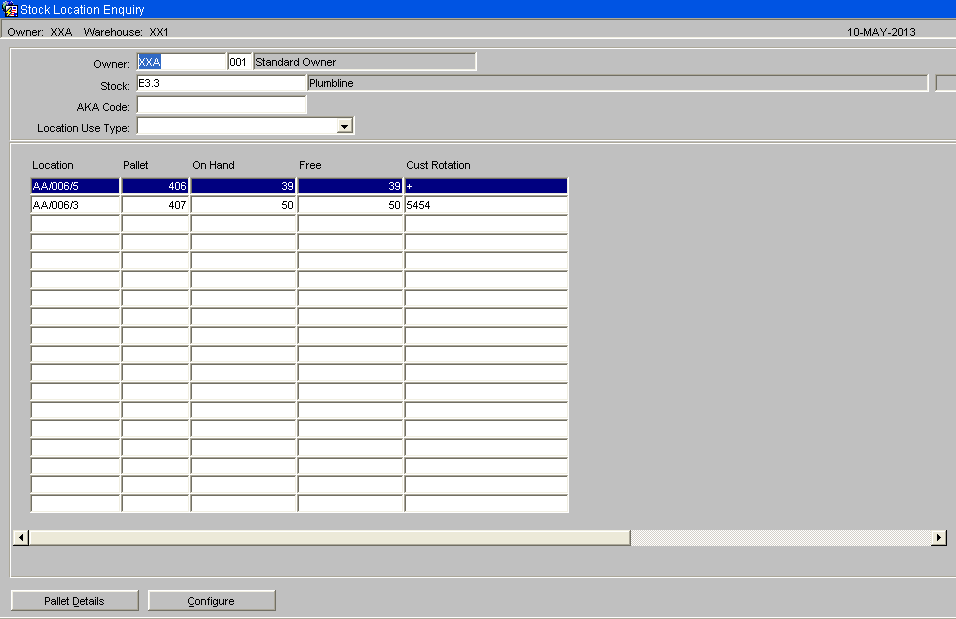
Stage 1- Go to the Bulk to Pick Replenishment screen (WHS0610)
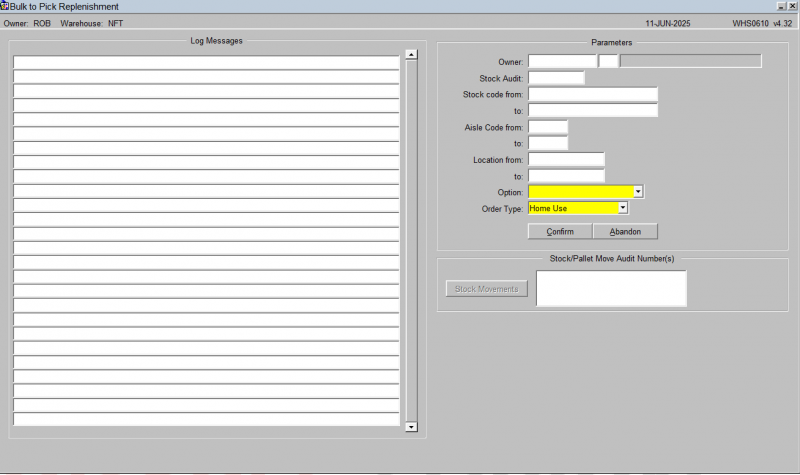
Parameters -
- Enter the Stock Code 'From' and 'To' values
- 'Option' should be set to 'Replenish Case Pick'
- 'Order Type' should be set to 'Home Use'
Then select the Confirm button and the system will check the pick face level of the required stock codes and if applicable a replenishment movement will be generated. The Log messages section will display all the information for the generated replenishments.
Stock Movements
Stage 2 & 3 -
The replenishment is now ready to be completed as standard in the Stock Movements screen or via RF if enabled.
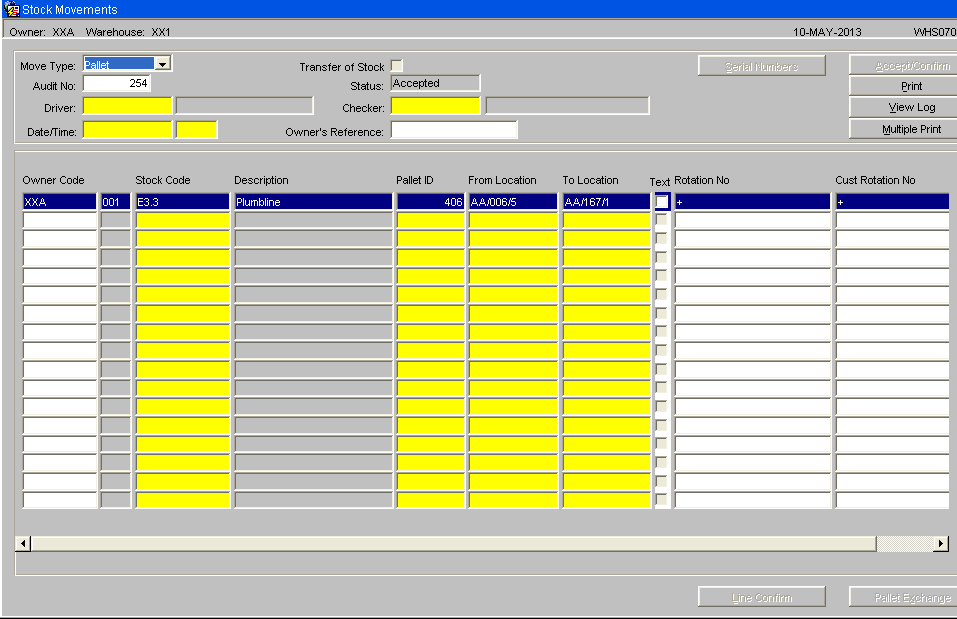
Parameters -
- Select the Accept/Confirm button unless the replenishment is to be cancelled.
- The Print button will now be enabled - select the button and print off documentation and labels if required.
- Upon printing of the documentation and the movement being completed in the warehouse select the Confirm button to compete the replenishment on the system.
REPLENISHMENT FROM ALLOCATION WHEN A PICK FACE RUNS TO ZERO OR BELOW
Setup
Owner Maintenance -

Parameters -
- Ensure that Allocation Rules are compatible with Replenishment, i.e. Allocation Rule '2' must be correctly enabled.
- Set Run Replenishment Report to 'Yes'
Stock Maintenance / Stock Warehouse / Unbonded Stock Locations -

The Stock Code must have an assigned Pick Face, the Replenish at and Replenish by fields are not looked at when the process is started, this system will automatically move the next best pallet into the pick face.
Replenishment during the Allocation Process
Process -
An order is placed onto the system (generally line type 1, certain other line types do not use the replenishment functionality i.e. 3 & 4 which are targeting a specific rotation or pallet)
The order is allocated and the system determines from the setup of the owner and the stock code what the optimum stock to allocate to the order is.
If pick faces are in use, replenishment is enabled and dependent on the remaining Owner setup parameters the system will check the pick face, if there is not enough stock in the pick face or if the pick face is empty and the order quantity is less than a full pallet the system will generate a replenishment movement on the next pallet to be picked.
The pallet to be moved will have stock that requires picking to satisfy an order, dependent on the owner requirement, the stock can be picked off the pallet at either the bulk location and then moved into pick or the pallet can be moved first and then picked from the pick location.
Order Entry
Standard order line, Product and Quantity -

Order Allocation
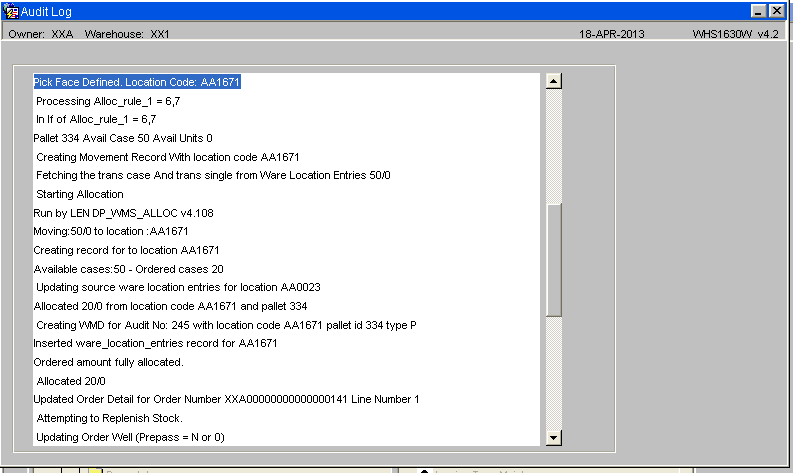
The order is allocated as normal, the audit log show the allocated pallet and the movement audit number.
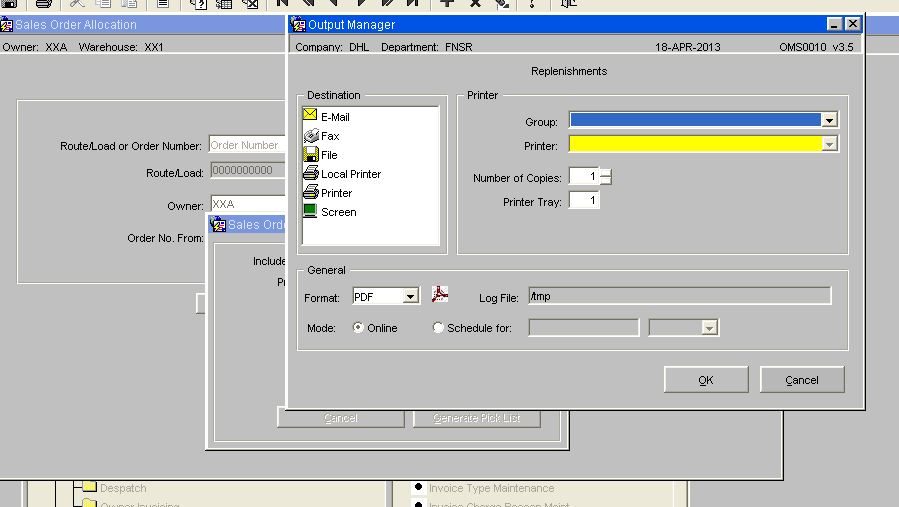
If a replenishment is generated a Replenishments report can be produced
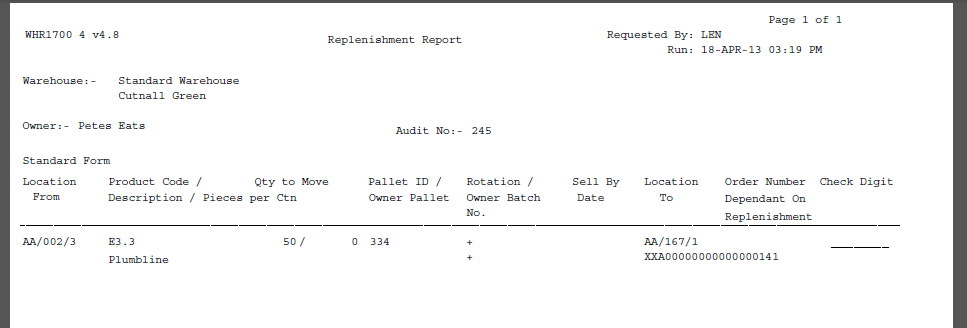
A report can be produced listing all replenishments and the dependent order number(s)
Stock Movement
The replenishment is now ready to be completed as standard in the Stock Movements screen or via RF if enabled.

- The Print button is now active - select the button and print off documentation and labels if required.
- Upon printing of the documentation and the movement being completed in the warehouse select the Confirm button to compete the replenishment on the system.
![]() Note: If a replenishment has been generated from allocation then it must be closed before the pick confirmation process can be completed
Note: If a replenishment has been generated from allocation then it must be closed before the pick confirmation process can be completed
REPLENISHMENT FROM ALLOCATION USING MINIMUM STOCK AND REPLENISHMENT LEVELS
Setup
Owner Maintenance -
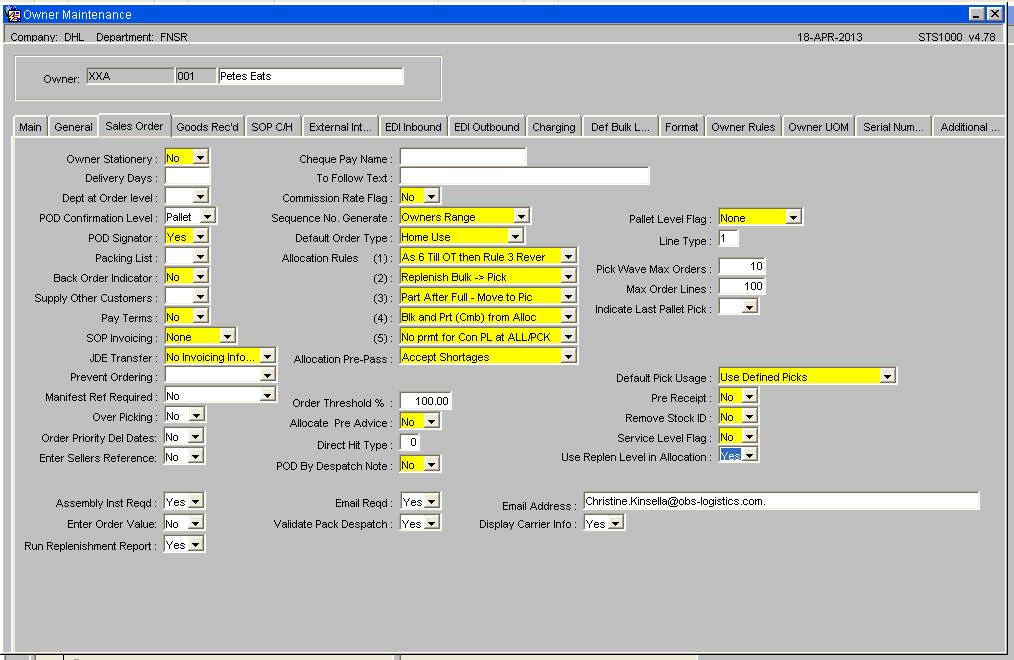
- Ensure that Allocation Rules are compatible with Replenishment, i.e. Allocation Rule '2' must be correctly enabled.
- Set Run Replenishment Report to 'Yes'
- Use Replen Level in Allocation to 'Yes'
Stock Maintenance / Stock Warehouse / Unbonded Stock Locations -
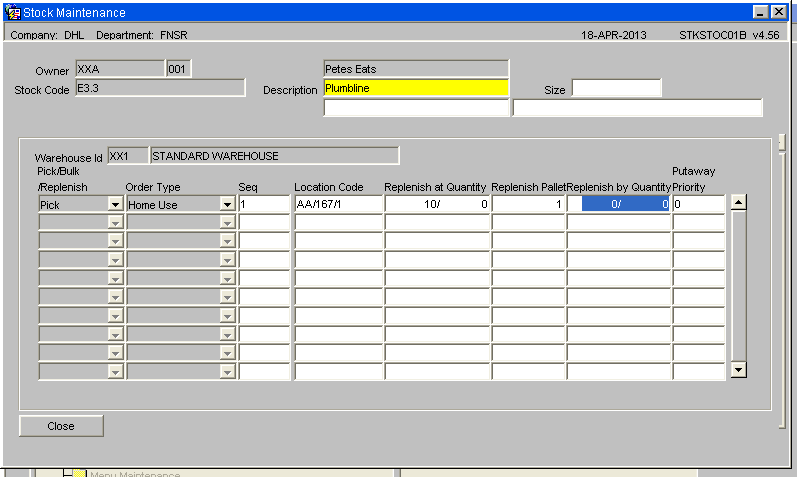
- The Stock Code must have an assigned Pick Face, a Replenish at Quantity and a Replenish by value
Replenish during Allocation using minimum Quantity Levels
Process -
An order is placed onto the system (generally line type 1, certain other line types do not use the replenishment functionality i.e. 3 & 4)
The order is allocated and the system determines from the setup of the owner and the stock code what the optimum stock to allocate to the order is.
If pick faces are in use, replenishment is enabled and dependent on the remaining Owner setup parameters the system will check the pick face, if there is not enough stock in the pick face or if the pick face is empty and the order quantity is less than a full pallet the system will generate a replenishment movement on the next pallet to be picked. In addition the system will then check the Replenish at Quantity, if the stock in the pick face is less than this value it will create a replenishment for the quantity of stock held in the Replenish by fields, i.e. pallet, case or unit or a combination.
Order Entry
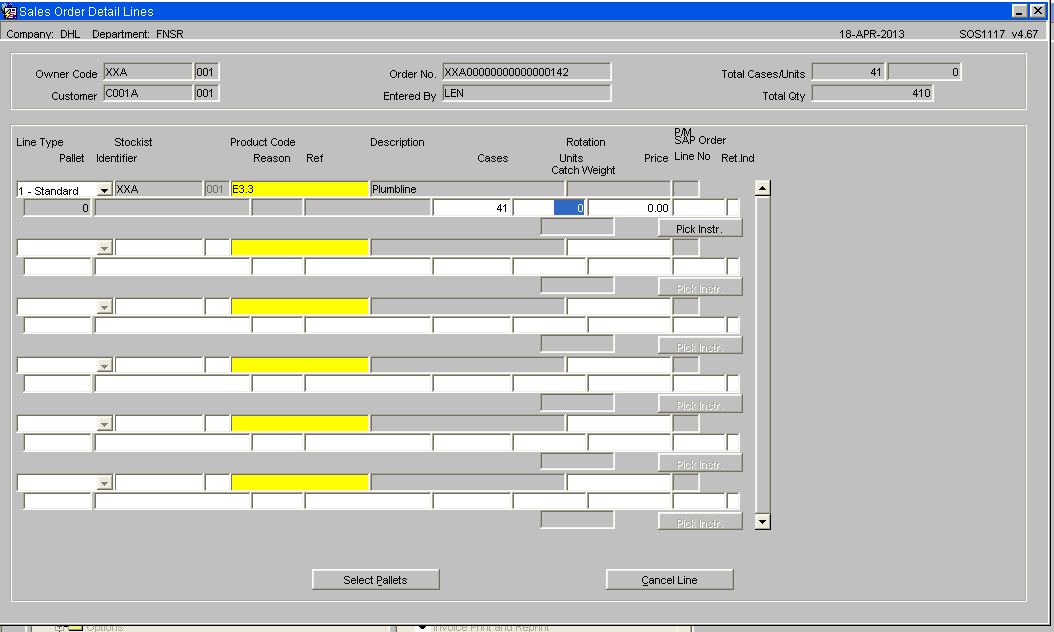
Order is entered on to the system -
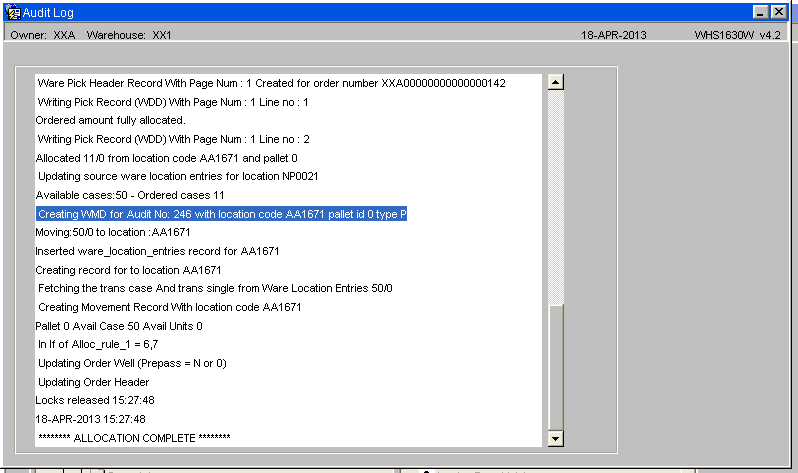
Order is allocated and the audit log shows a generated replenishment due to the stock levels in the pick face falling below the minimum quantity level.
Pick List
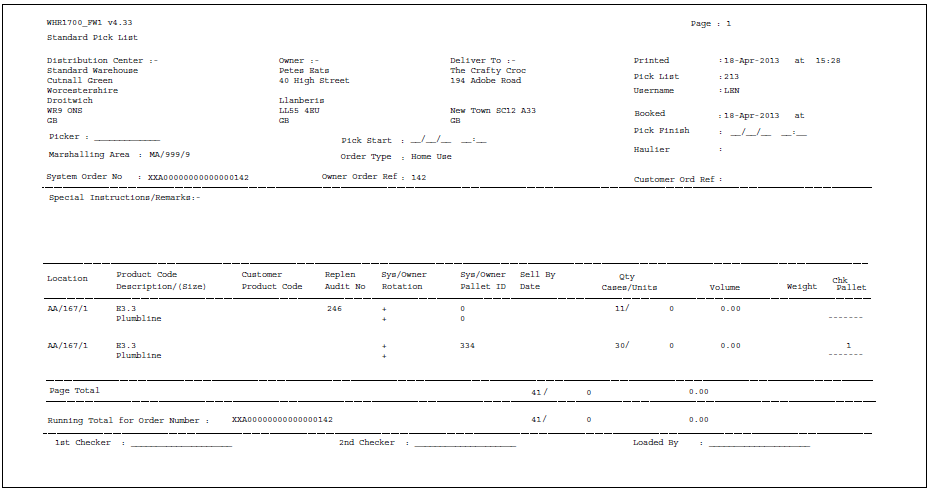
Generated Pick List showing the Replen Audit No:
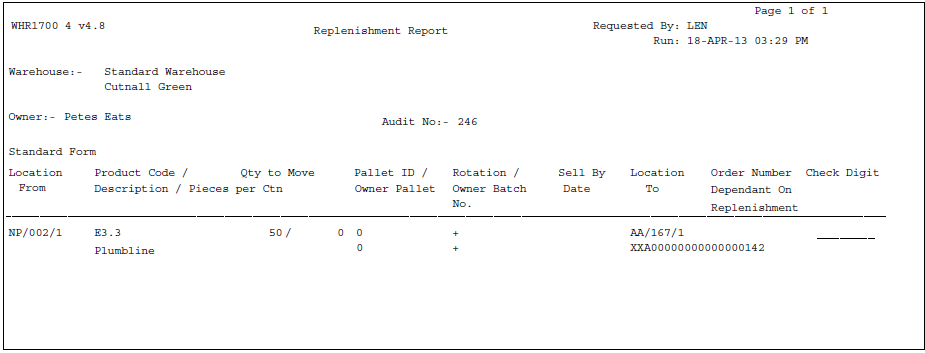
System generated Replenishment Report -
Stock Movement
The replenishment is now ready to be completed as standard in the Stock Movements screen or via RF if enabled.
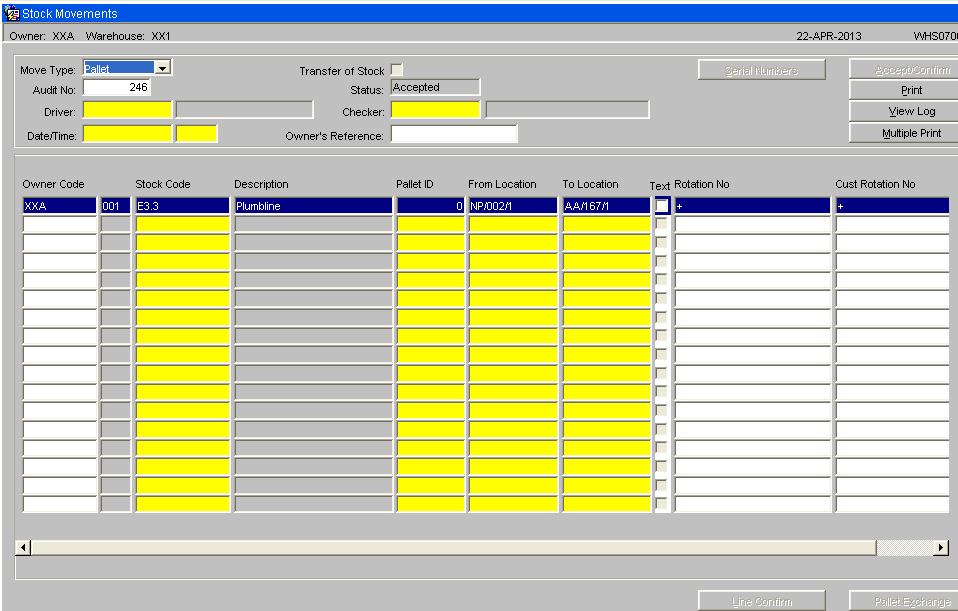
- The Print button is now available - select the button and print off documentation and labels if required.
- Upon printing of the documentation and the movement being completed in the warehouse select the Confirm button to compete the replenishment on the system.
![]() Note: Unlike the previous process, it may not be necessary for the movement to be completed before entering the pick details in Pick Confirmation as the there be sufficient stock in the pick face to satisfy the order, this movement will in effect be a top up.
Note: Unlike the previous process, it may not be necessary for the movement to be completed before entering the pick details in Pick Confirmation as the there be sufficient stock in the pick face to satisfy the order, this movement will in effect be a top up.
SUPPORTING PROCESSES
Configurable EDI
Using the configurable EDI functionality it is possible to upload a file containing the Stock Code, Pick Face, Minimum Quantity and Replenish Quantity.
All key values are maintained in the EDI Structure STK_LOCATION.
![]() Note: Refer to the EDI Wiki Guide for details on setup of the Configurable EDI functionality
Note: Refer to the EDI Wiki Guide for details on setup of the Configurable EDI functionality
Reports
Pick Location by Stock Report (WHS1001) -

The report shows all stock codes setup with assigned pick faces with their replenishment levels.
Oracle Data Extract (ORS0100) -
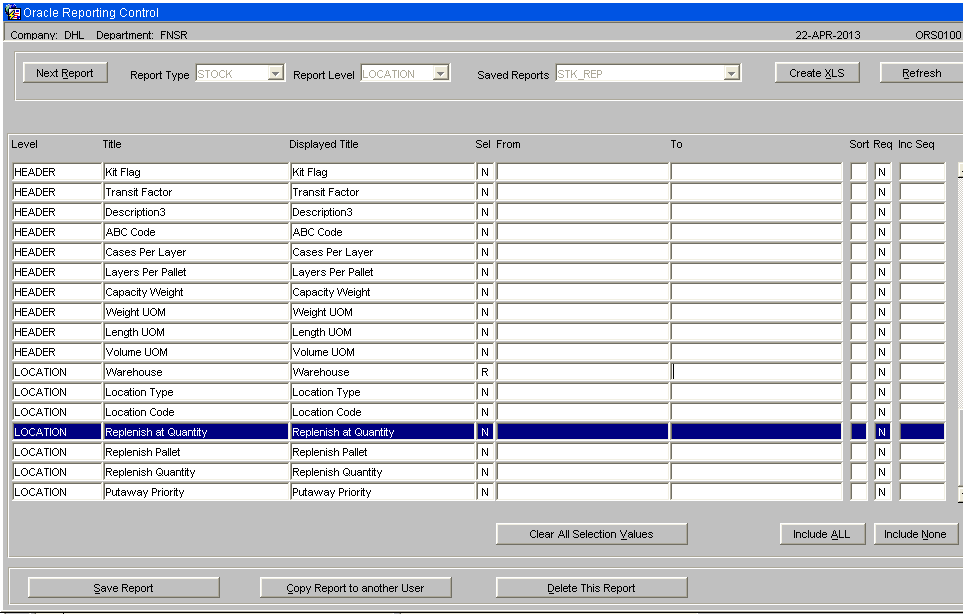
Using the Oracle Data Extract screen (ORS0100) the system allows for the extraction and reporting of data to help setup and maintain pick faces and their replenishment levels.
Appendix A: Document History
A.1 References
| Ref No | Document Title & ID | Version | Date |
|---|---|---|---|
| 1 | UG 352167 C-WMS Standing Data Set-up Guide | v2.0 | 13/11/2018 |
| 2 | |||
| 3 |
A.2 Glossary
| Term or Acronym | Meaning |
|---|---|
| Ad Hoc (WCS) | A task instigated on the device (spec. Ad Hoc Pallet Move), rather than a task instigated from the WMS and Stock Control. |
| Advice Note Number | An external reference linked to a Goods Receipt. |
| Aisle (WMS) | A component of a location; usually a space through rows of racking or storage locations; a collection of locations; |
| Allocation (order) | The systemic act of identifying and ring-fencing product matching the order requirements, following proscribed warehouse rules. |
| Anchor Point (WMS) | A starting location for a search for a suitable storage location; auto-putaway location suggestion start point. |
| Area (WMS) | A collection of aisles; an area in the warehouse for a particular purpose. |
| Batch (WMS) | A production batch of a product; a quantity of product that is considered to have the same characteristics; |
| Bay (Warehouse) | A physical loading or unloading point for the warehouse. |
| Bay (WMS) | A component of a location; usually a space between uprights in racking, comprising several levels (horizontal beams). |
| Bay Diary | The mechanism for booking hauliers inbound/outbound and assigning bays. The OBS Logistics system is CALIDUS Bay Diary. |
| Block Stack | A stable stack of pallets. |
| Booking | A time slot for a bay, booked with a Carrier/Haulier. |
| Bulk (WMS) | Bulk storage; Usually full-pallet storage areas, racked or stacked. |
| Cancellation (WCS) | The facility to cancel a task due to some problem, identified by the user when performing the task. |
| Carrier; Haulier | The transport company (by road or sea). |
| Check Digit (WMS) | A short code, usually randomly generated and stored against a location, used to help identify that a user is at the right location before they proceed with a warehouse task. |
| Container | The actual physical container, identified uniquely by the Container Number. The Container will be identified as a Container Type. |
| Container Type | Descriptive of the use and capability and physical characteristics of a container. Container types are 40ft End Loader, Reefer, etc. |
| Container Yard | The storage areas for full and empty locations in the facility. The OBS Logistics system to manage this area is CALIDUS Container Yard. |
| CSV | Character-separated values; a text file with multiple rows and values, usually separated with commas. |
| C-WCS | CALIDUS WCS, the name of the OBS Logistics Warehouse Control system |
| C-WMS | CALIDUS WMS, the name of the OBS Logistics Warehouse Management system |
| Dead Leg (WCS) | A movement of a truck without a pallet; wasted resource. |
| Despatch | The final physical stage of an order; handover of goods to the haulier. |
| De-stuffing | The act of emptying a container and storing the contents in the warehouse. |
| Drive-In | A drive-in location, typically multi-level, multi-deep location. |
| Dry Van | Any type of non-refrigerated container. |
| Dual Cycling | Processes utilizing P&D locations for interleaving tasks in and out of specific areas, reducing dead leg movements. |
| EDI | Electronic Data Interchange; any form of automatically or semi-automatically uploading or downloading information from a computer system without manually re-keying the information. |
| ERP | Enterprise Resource Planning; a system for this. |
| Exchange (WCS) | Specifically Pick Exchange or Task Exchange. The process of allowing a user to select a different pallet in a multi-pallet location and exchanging the expected pallet for this one. If the pallet is planned for another task, task exchange will complete this task instead of the expected one first. If the pallet is not planned, pallet exchange will swap the pallet (if suitable). |
| GR; GRN | Goods Receipt; Goods Receipt Number or Note |
| High Bay | Typically tall (greater than 5 level) racking, usually full pallet storage, usually Narrow Aisle. |
| Inbound (Booking) | A booking linked to a Goods Receipt. |
| JIT | Just In Time; processes designed to trigger at the last instant. |
| KPI | Key Performance Indicator. |
| Level (WMS) | A component of a location; usually the vertical compartments of an area, delineated by horizontal beams. |
| Loading | The act of loading pallets onto a vehicle. |
| Location (WMS) | A uniquely identified space in the warehouse for storage of product. There are many types, most commonly Floor locations (for example, Marshalling, Inbound), Racking or Bulk Storage Locations and Pick faces. |
| Manifest | The contents of a vehicle or container. |
| Marshalling | The act of bringing pallets for an order or load together; an area to do so. |
| Multi-deep | A location with 2 or more pallets stored sequentially i.e. only one can be accessed at a time. |
| NA (WCS) | Narrow Aisle; usually any area in the warehouse that is restricted access due to space limitations, Narrow Aisles have associate P&D locations. |
| Outbound (Booking) | A booking linked to a Sales Order. |
| P&D | Pick-up and Drop-off locations; locations used to control the handover of pallets between distinct areas, for example between chambers and the wider area of the warehouse. |
| PI; Perpetual Inventory | The act of continuously checking locations in a warehouse, identifying and correcting product quantity issues. Usually used in Bulk environments rather than Pick Faces. In pick faces, this process is called is called Residual Stock Balance and usually takes place after picking from a pick face. |
| Pick Face | A location designed for picking part of a pallet of stock. Usually a low- or ground-level location. |
| Pick List (order) | The instructions to pick pallets or cases from locations; the paper report associated to this; the stage of preparing these instructions; the sending of these instructions to WCS. |
| PO | Purchase Order. |
| Pre-advice; Goods Receipt Pre-advice | An advanced notification of what is being received. Part of a manifest. Pre-advices can be stock and quantity, or individual pallet level. |
| Putaway | The physical move of a pallet to a storage location as a result of receiving it into the warehouse. |
| RAG | Acronym for Red/Amber/Green, a traffic light colouration system depicting (in sequence) Errors, Warnings or Informational messages. Usually used in operational monitoring to effectively display when certain processes are not working as expected. |
| RDT | Radio Data Terminal. |
| Reefers | Refrigerated Containers. |
| Replen; Replenishment | The act of moving product (usually a pallet) from bulk storage to a pick face. |
| Reposition (WCS) | The facility to change the location of a movement or putaway when at the final destination, sue to some issue discovered when performing the task. |
| RF | Radio Frequency; An RF device is an RDT, typically used by CALIDUS WCS for executing warehouse tasks. |
| SCR; CR | Software Change Request. |
| Short Allocate | The process of not fulfilling an order due to failure to identify sufficient product at Allocation. |
| Short Pick | The process of not fulfilling an order due to failure to identify sufficient product when picking. May also be used as a term to indicate Short Allocation. |
| SO | Sales Order. |
| Truck Types | Plants, Mechanical Handling Equipment. For example, Reach trucks, Counter-balance trucks, pallet riders, etc. |
| UOM | Unit of Measure. |
| WA (WCS) | Wide Area; usually any area in the warehouse that is not restricted access due to space limitations, for example, floor areas, not Narrow Aisle. |
| WCS | Warehouse Control System |
| WMS | Warehouse Management System |
A.3 Document History
| Version | Date | Status | Reason | By |
|---|---|---|---|---|
| 1.0 | 13/05/2013 | Issue | Initial Version | LBW |
| 2.0 | 15/11/2018 | Issue | Updated version for formatting | ANW |
A.4 Authorised By
Matt Tipping | Aptean Project Manager | _____________________________ |
Tony Walker | Aptean Consultant | _____________________________ |